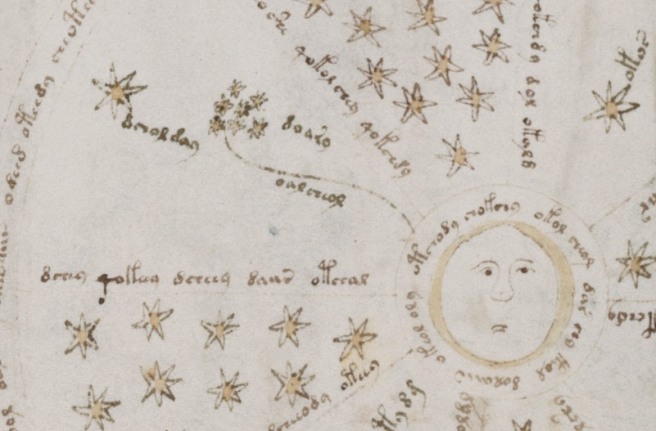The one thing constant when examining the VM is the fact that nothing is as it looks at first glance. Whether this is Voynich’s personally devised conundrum, designed to enhance the appeal of the book, or simply the result of an otherwise innocent enciphering scheme developed by a 15th century scholar, Voynicheros learn quickly not to trust superficial appearances.
This thought struck me while perusing Julian Bunn‘s new book about the Puzzles of the VM, and coming across his description of f68r2, which is generally assumed to depict the Moon, the open star cluster of the Pleiades, and maybe Aldebaran, the singularly brightest star in the Pleiades vicinity.

As usual, attempts to use the names “Pleiades” and “Aldebaran” as cribs to break the VM cipher led to nothing, and also the mysterious wavy line connecting the stars and the Moon has only been met with tortuous, hardly convincing explanations. But what if these are not the Pleiades?
In terms of astronomy, the Pleiades are an open cluster of around 500 stars in relative proximity to Earth. Depending on visibility conditions, usually either six or eight, but rarely seven of these stars can be discerned with the naked eye, since numbers 7 and 8 have almost the same apparent brightness. In many cultures, the Pleiades are nevertheless associated with the number “7” (probably due to the “magic” qualities of this number). The Pleiades supposedly are depicted in the shape of seven dots on the early bronze age Nebra sky disk and are also known in German as the “Siebengestirn”, the “seven stars.” OTOH, in japanese astronomy six of its stars form the constellation of “Mutsuraboshi” (conveniently meaning “six stars”), and the paintings in the caves of Lascaux apparently feature a suspicious cluster of six, not seven stars.
So, under the impression that interpreting the f68r2 constellation as the Pleiades is leading us nowhere, what else could it depict?
I was reminded of the fact that classical astrology always spoke of seven “planets” — not planets in the modern astronomical sense, but objects changing their position relative to the fixed stars. Namely, these were the Sun and the Moon, plus those bodies visible to the naked eye we consider planets today: Mercury, Venus, Mars, Jupiter, and Saturn. What if the f68r2 objects really depicted the seven planets — Where would that lead us?
Being a reader of comic books, the wavy line between Moon and “Pleiades” reminded me of “speed lines”, used to indicate motion in comics. By analogy, let’s take a wide leap and say, the “Pleiades” are moving away from the Moon in this picture — after the Moon has been hit by “Aldebaran”, maybe? Using this as a starting point, as usual there is no difficulty in coming up with wild speculations: Is this maybe a picture explaining an early astronomical theory about the creation of the solar system — A massive star struck the Sun, and the collision broke seven pieces of rock free which went on to become the planets, Moon and Earth?
Of course, that would be an unusually advanced theory for a manuscript presumably written in the 15th century — It would predate Copernicus‘ ideas of a heliocentric universe by at least half a century.*) Also, it requires one to assume that the VM author got a little confused by his own genius when he drew the Moon in the centre of the picture rather than the Sun. (And it pretty clearly is the Moon.**) On the other hand, it has been assumed that the VM is a collection of advanced scientific theories, and if the balneological section is interpreted as a treatise about anatomy, similar advanced views on astronomy could not be ruled out either.
It is certainly tempting to fantasize that the author had developed a theory for the creation of the planets which could still have held up its head in the 19th century. But, the longer I sort my thoughts about it, the less I believe in it. While I’m also unconvinced that the f68r2 object are the Pleiades, the “heliocentric hypothesis” simply requires too many stretches of the imagination.
So, once more, not only the first appearance, but also the second one of a feature in the VM seems to be misleading.
*) While the idea of a heliocentric universe had been known since antiquity, it had never found much acceptance before the middle of the 16th century.
**) A “weaker” version of the heliocentric hypothesis would be the assumption that the body in the centre of f68r2 is not the Moon, but the Earth. In that case, one could assume a geocentric universe being depicted, with the planets being the result of the collision of the Earth with a massive object which later vanished into deep space again. This being a very early depiction of Earth in a modern astronomical context, it’s unclear how the VM author would have drawn it.